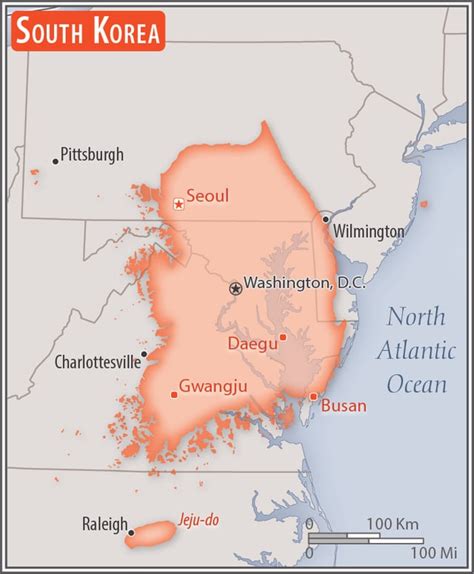How Big Is South Korea Compared To The United States

South Korea, officially known as the Republic of Korea, is a country located in East Asia, and its size is often compared to that of the United States to provide a better understanding of its geographical scale. To put it into perspective, the total area of South Korea is approximately 100,363 square kilometers (38,750 square miles), which is roughly the size of the state of Indiana in the United States. In contrast, the United States covers a vast area of approximately 9,833,517 square kilometers (3,805,927 square miles), making it about 98 times larger than South Korea.
In terms of population, the United States has a significantly larger population, with approximately 331 million people, whereas South Korea has a population of around 51 million people. This means that the United States has about 6.5 times the population of South Korea. Despite the difference in size and population, South Korea has a highly developed economy and is considered one of the most technologically advanced countries in the world. Its strategic location on the Korean Peninsula, bordering North Korea to the north, the Yellow Sea to the west, and the Sea of Japan to the east, has played a significant role in shaping its history, culture, and economy.
Key Points
- South Korea's total area is approximately 100,363 square kilometers (38,750 square miles), comparable to the size of the state of Indiana in the United States.
- The United States is about 98 times larger than South Korea in terms of total area.
- South Korea has a population of around 51 million people, whereas the United States has a population of approximately 331 million people.
- Despite its smaller size, South Korea is a highly developed country with a strong economy and advanced technology.
- South Korea's strategic location on the Korean Peninsula has significantly influenced its history, culture, and economy.
Geographical Comparison

A geographical comparison between South Korea and the United States reveals some interesting differences. South Korea is a relatively small country, with a total coastline of approximately 2,413 kilometers (1,499 miles), whereas the United States has a vast coastline of about 19,928 kilometers (12,383 miles). In terms of climate, South Korea has a temperate climate with four distinct seasons, whereas the United States has a diverse range of climates, from tropical to polar, depending on the region.
Regional Variations
Both South Korea and the United States have regional variations in terms of geography, climate, and culture. In South Korea, the southern region is generally warmer and more humid than the northern region, which is colder and drier. Similarly, in the United States, the southern states tend to be warmer and more humid, while the northern states are generally colder and more temperate. These regional variations have a significant impact on the economy, culture, and lifestyle of the people living in these regions.
| Country | Total Area (km²) | Population (million) | Coastline (km) |
|---|---|---|---|
| South Korea | 100,363 | 51 | 2,413 |
| United States | 9,833,517 | 331 | 19,928 |

Economic Comparison

From an economic perspective, South Korea and the United States are both highly developed countries, but they have distinct economic profiles. South Korea has a high-tech economy, with a strong focus on electronics, automobiles, and shipbuilding. The United States, on the other hand, has a more diversified economy, with significant contributions from the service sector, finance, and technology. The trade relationship between the two countries is significant, with the United States being one of South Korea’s largest trading partners.
Trade and Investment
The trade and investment relationship between South Korea and the United States is complex and multifaceted. South Korea is a major exporter of goods such as electronics, automobiles, and textiles, while the United States is a significant importer of these goods. At the same time, the United States is a major investor in South Korea, with significant investments in the technology and manufacturing sectors. This close economic relationship has contributed to the growth and development of both countries.
In conclusion, the comparison between South Korea and the United States reveals significant differences in terms of size, population, geography, and economy. Despite these differences, both countries have developed strong relationships in trade, investment, and culture, which have contributed to their growth and development. Understanding these differences and similarities is essential for fostering greater cooperation and exchange between the two nations.
What is the total area of South Korea compared to the United States?
+South Korea has a total area of approximately 100,363 square kilometers (38,750 square miles), whereas the United States has a total area of approximately 9,833,517 square kilometers (3,805,927 square miles), making the United States about 98 times larger than South Korea.
How does the population of South Korea compare to that of the United States?
+South Korea has a population of around 51 million people, whereas the United States has a population of approximately 331 million people, making the United States about 6.5 times more populous than South Korea.
What are the main differences in the economy of South Korea and the United States?
+South Korea has a high-tech economy, with a strong focus on electronics, automobiles, and shipbuilding, whereas the United States has a more diversified economy, with significant contributions from the service sector, finance, and technology.



